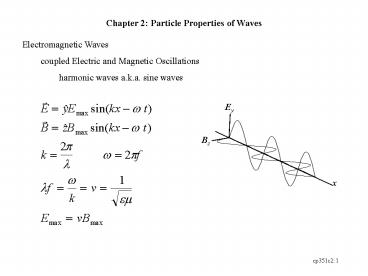Chapter 2: Particle Properties of Waves - PowerPoint PPT Presentation
1 / 20
Title:
Chapter 2: Particle Properties of Waves
Description:
Wave-particle 'duality' interference and ... collision between a phton and a charged particle initially at rest ... of particle and antiparticle ... – PowerPoint PPT presentation
Number of Views:865
Avg rating:3.0/5.0
Title: Chapter 2: Particle Properties of Waves
1
Chapter 2 Particle Properties of Waves
Electromagnetic Waves coupled Electric and
Magnetic Oscillations harmonic waves a.k.a. sine
waves
2
electromagnetic spectrum l c/f
f (Hz)
l (m)
4.3 x1014 - 7.5 x1014 (Hz)
Visible Light
ROYGBIV
700 nm - 400 nm
3
Principle of Superposition add instantaneous
amplitudes
Constructive interference
Destructive interference
4
Diffraction of light waves
5
Ideal thermal radiator Blackbody Radiator
IC
observed contiunuous spectrum vs. classical
theory Ultraviolet Catastrophe
I
l
6
Theoretical black body standing wave modes in a
(3-d) cavity
7
Example 2.1 A certain 660 Hz tuning fork can be
considered as a harmonic oscillator with a
vibrational energy of 0.04J. Compare its energy
quantum of energy for the tuning fork with its
vibrational energy. Compare the forks quantum
of energy with those of an atomic oscillator
which emits a frequency of 5.00x14 Hz.
8
Photoelectric effect Classical problems no delay
in emission of electrons KE of electrons
indepentdent of intensity KE of electrons depends
upon frequency of light effect occurs only above
threshold frequency n0 Einstein quantize light
(photons) 1 photon absorbed gt 1 photoelectron
released Conservation of Energy
9
Example 2.2 Ultraviolet light of wavelength 350
nm and an intensity of 1.00 W/m2 is directed at a
potassium surface (f 2.2eV). (a) Find the
maximum KE of the photoelectrons. (b) If 0.50
percent of the incident photons produce
photoelectrons, how many are emitted per second
if the potassium surface area is 1.0 cm2?
Thermionic Emission kT f gt random motion
kicks electrons loose Wave-particle
duality interference and diffraction wave
phenomena photoelectric effect, etc. particle
phenomena gt intensity probability for
individual photons
10
X-Ray production bremsstrahlung (braking
radiation) inverse photoelectric effect 1
electron (KE) in gt photon (E hf) out
maximum energy photon get all of electrons
KE electron KE from accelerating potential
11
Example 2.3 Find the shortest wavelength present
in the radiation from an X-ray machine whose
accelerating potential is 50 kV.
12
Typical continuous x-ray spectrum
Some target materials produce sharp maximum in
the x-ray spectrum
13
X-ray diffraction how to measure the wavelength
of x-rays
qi
qr
Constructive Interference when qi qr (0th
order)
qi
d
Path difference 2d sin qi Constructive
Interference n l 2d sin qi n 1, 2, 3
... note path deflected by 2q
14
Compton effect an elastic collision between a
phton and a charged particle initially at rest
particle nature of light (photons)
(Relativistic) conservation of energy and momentum
15
lC 2.426 pm for electrons
16
Example 2.4 X-rays of wavelength 10.0 pm are
scattered from a target. (a) Find the wavelength
of the x-rays scattered through an angle of 45
degrees. (b) Find the maximum wavelength of the
scattered x-rays. (c) Find the maximum KE of the
recoil electrons.
17
pair production conservation of energy,
momentum other conservation laws E mc2
e
e -
creation of particle and antiparticle
(antimatter) antiparticle has same mass, opposite
charge etc. particle/antiparticle pair can
anihilate to create a pair of photons e e -
-gt g g
18
Example 2.5 Show that pair production cannot
occur in empty space. (Hint look at
relativistic conservation of energy and momentum)
Example 2.6 An electron and a positron are
moving side by side in the x direction at
0.500c when they annihilate each other. Two
photons are produced that move along the x -axis.
(a) Do both photons move in the x direction?
(b) What is the energy of each photon?
19
Photon Absorption Three chief mechanisms for
x-ray and gamma ray photons to interact with
matter photoelectric effect (photon
absorbed) Compton scattering (photon energy
decreased) pair production (photon converted to
pair) The dominant mechanism depends upon
material and photon energy A slab of material
will reduce intensity
20
Example 2.7 The linear attenuation coefficient
for 2.0 MeV gamma rays in water is 4.9 m-1. (a)
Find the relative intensity of the gamma rays
after it has passed through 10 cm of water. (b)
How far must the beam travel in water before
being reduced to 1 percent of its original value?
Problems 2,5,6,8,11,12,15,17,19,20,21,22,23,26,2
7,29,32,39,43,45,46,47 skip 2.9 or read at your
liesure































